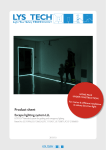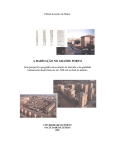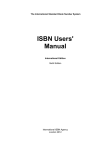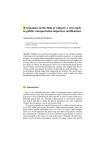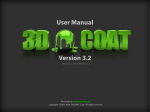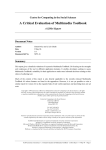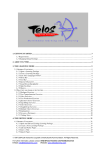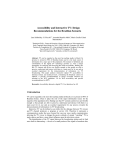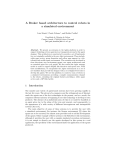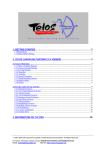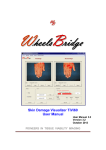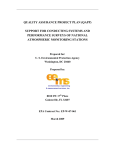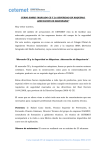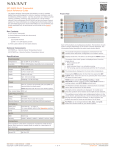Download Evaluating the Utility and Usability of an Adaptive Hypermedia
Transcript
Evaluating the Utility and Usability of an Adaptive Hypermedia System Kristina Höök SICS, Box 1263, 164 28 Kista, Sweden +46-8-752 15 00, [email protected], http://www.sics.se/~kia/ Abstract We have evaluated an adaptive hypermedia system, named PUSH, and compared it to a non-adaptive variant of the same system. The PUSH system either infers users’ information-seeking tasks from their actions at the interface, or the users can set the task themselves. Based on the information-seeking task, the system chooses what to show and what to hide in a page using a stretchtext1 technique. The purpose is to avoid information overload. We studied how successful the subjects were in retrieving the most relevant information, and found that the subjects’ solutions were influenced by the choice made by the adaptive system. We also studied how much the adaptivity reduced the amount of actions needed, and found that subjects made substantially fewer actions in the adaptive case. A third measurement was the subjects subjective preferences for the adaptive or the non-adaptive system, were we found that the subjects clearly preferred the adaptive system. It seems as if it requires less decisions on behalf of the subject, thereby reducing their cognitive load. We also discuss the general problem of evaluating adaptive systems. Keywords: Adaptive hypermedia, empirical evaluation, intelligent interfaces, usability 1 Introduction Adaptive hypermedia is a new direction of research within the area of user-adaptive systems. The earliest systems dates back to 1990, but most systems have been developed and described during the last three years (1993-1996). As Peter Brusilovsky (1996) points out, hypermedia has gained ground during the last few years as a tool for userdriven access to information. In particular, the widespread use of www (which is hypertext based) has set a de facto standard for documentation of various kinds. The simplicity of the hypermedia interaction model is part of why it has been so successful. From a user perspective, all one has to do is to move between ”pages” of information by following ”links”. Usually, the pages of information consists of text and/or some 1 Stretchtext is a special kind of hypertext. Instead of moving to a new page of text, an activation of a hotword in a stretchtext will instead replace the activated hotword (or a phrase with this word), extending the text of the current page (Brusilovsky 1996). 1 ready-made pictures. Following a link is done by clicking on a hotword 2 or clicking on a hotspot in the graphics. The result of the action is (usually) that we move to another page of information. Unfortunately, hypermedia also has some serious drawbacks. When the information space grows to be very large, users easily become ”lost in hyperspace” (Conklin 1987). Another problem is how to design the information space to allow for users with different goals and needs to be able to navigate and retrieve information that is relevant to them. According to Brusilovsky (1996), it is in these cases, when the system is expected to be used by people with different goals and knowledge and where the hyperspace is reasonably big, that it is worthwhile making the hypermedia tool adaptive. An adaptive hypermedia system can help the user to search for and isolate the information most relevant to his/her needs, thereby limiting the hyperspace. Adaptive hypermedia is different from other kinds of adaptive systems in that it marries the passive hypermedia information model with the means to make systems actively adapt to the user. The systems implemented so far occupy the middle-ground between user-controlled and system-controlled information retrieval. The system we studied here, PUSH, was designed to adaptively help users to find information in an on-line manual (Höök et al. 1996, in press, Höök et al. 1995). The system utilises Netscape and Java on the client side to realise the interface, while on the server side we have implemented the database and the adaptive system in Prolog (Espinoza and Höök 1996). The interface in WWW offers some interesting interaction possibilities not normally available in Netscape: a form of stretchtext, hotlists that associate hotwords with follow-up questions on the hotword, and local maps of the information space that can be used to navigate in the information space. In the study, we also evaluated these aspects of the interface, even if the main goal was to evaluate the adaptive behaviour of the system. The adaptive parts of the PUSH system were designed to fulfil two goals: • to reduce the information overflow problem, • to aid the user in getting at the most relevant information, given that the user has a particular information seeking task. The adaptation made by the system does not affect how the user can navigate between pages, it only affects how much information is presented within a page. A problem with adaptive systems in general is that they might make wrong adaptations based on guesses they make about the user (Kay 1994). It is therefore of crucial importance to allow the user to control the adaptivity and to alter the assumptions made by the system. We shall explain how PUSH allows the user to correct its faulty assumptions, and how users perceived those possibilities. Before we turn to our study, in which we compare PUSH to a non-adaptive variant of the same system, we discuss some of the difficulties of evaluating adaptive systems, and we also provide an introduction to the PUSH system and the target domain. 2 Hotword is used to denote the word or icon that the user can click on to get to the next page of information (Kobsa et al. 1994). 2 2 Evaluating adaptive systems Evaluating systems is a difficult task, and it becomes even more difficult when the system is adaptive. It is of crucial importance to be able to distinguish the adaptive features of the system from the general usability of the designed tool. This is probably why most studies of adaptive systems are comparison of the system with and without adaptivity (Meyer, 1994; Boyle and Encarnacion, 1994; Brusilovsky and Pesin, 1995; Kaplan et al., 1993). The problem with those studies is obvious: the non-adaptive system may not have been designed ’optimally’ for the task. At least this should be the case since adaptivity should preferably be an inherent and natural part of a system - when removed the system is not complete. Still, it is very hard to prove that it is actually the adaptivity that makes the system better unless that condition can be compared with one without adaptivity. The study presented here is no exception to the ”comparative studies” set-up. Still, as we shall see, the non-adaptive variant of the system we exposed the subjects to was a good system in itself. It did not overload the users with information, but just kept everything initially closed, thus forcing the subjects to open those piece of information that they believed would be relevant to their needs. Also, the non-adaptive system offered all the other features mentioned above: stretchtext, hotlists and maps to the information space. An alternative view on how to study adaptive system, is put forth by Oppermann, (1994), who prefers to see them as part of the design cycle. Since adaptivity is a complex machinery, there must be several rounds of studies which aid the designers in getting the adaptivity right. For example, if the adaptive hypermedia system is supposed to provide different kinds of information to users depending on their knowledge, goal or needs, it may be necessary to make several studies before the right relevance-criterion can be set up between the users goal and the preferred information content (or information presentation). Prior to the study described here, we did a couple of ”bootstrapping” studies with the goal of finding the relevant relations between users’ informationseeking tasks and the information the system should adaptively provide the users (Espinoza and Höök 1996). The results from these studies fed into our design of the relevance criterion that our adaptive mechanisms make use of. Another important issue is what to measure when evaluating the adaptivity. There are few studies of adaptive systems in general, and even fewer of adaptive hypermedia. In the studies of adaptive hypermedia by (Boyle and Encarnacion 1994; Brusilovsky and Pesin 1995; Kaplan et al. 1993) the main evaluation criterion is task completion time. This should obviously be one important criterion by which some systems should be evaluated. In our case, though, the goal of the adaptive hypermedia system is to provide the user with the correct, most relevant, information and make sure that users are not lost on their way to this information. The time spent in retrieving information is not relevant, the effectiveness of the search and the quality of the result is. Boyle and Encarnacion also measured reading comprehension through a diagnostic test put to the subjects after having used the system. Kaplan et al. measured how many nodes the users visited - in their case the more nodes the users visited, the better. Finally, Brusilovsky and Pesin measured how many times their students revisited ”concepts” they were attempting to learn. The evaluation of our PUSH system was designed to address the goals of the system, namely to reduce information overflow and aid the users in finding the most relevant information. So we wanted to measure whether the users actually found the most rele- 3 vant information and whether or not they were lost in the information space while searching. A related measurement is the amount of ”within-page” navigation. A good adaptation should preferably open up the most relevant information, and the user should not be forced to open more information in order to be satisfied, i.e. the fewer actions that affect the contents of the page, the better. Finally, we were also interested in subject’s own evaluation of how well the adaptive system worked compared to the non-adaptive one, and whether they felt in control of the adaptive parts of the system. A last difficulty in making studies of adaptive systems, is in the procedure of the study. Most adaptive systems will be really useful when they are part of the users work for a longer period: only during that longer period can we see how the users needs and goals varies in a ”natural” way. Obviously, this may not be feasible in a research project which has to be finished in limited time. Instead, we have to make the subjects solve a pre-defined set of realistic tasks to which we know that the system will be able to adapt. 3 The PUSH system The system studied here is named PUSH (Plan- and User Sensitive Help - and is described in Höök et al. 1996, in press; Espinoza and Höök 1996). It is an adaptive hypermedia system that utilises Netscape and Java on the client side to realise the interface, while on the server site we have implemented the database and the adaptive system in SICStus Prolog objects (SICStus). The hypertext database contains information about a software development method, SDP, consisting of processes and object types. The method is documented in more than 500 documents consisting of 5 - 20 pages of text and graphs each. In our studies of the domain and its users (Bladh and Höök 1995), we found that the main problem for users was in retrieving the right information from this large information space. We know that users avoid scrolling down a page to see past the first page of information, (Bladh and Höök 1995, Nielsen 1995), and so it is important to show only the most relevant information. Once the right information was found by the users, they sometimes also experienced difficulties in interpreting the information. Again, this tells us that it is important to choice the right, most relevant information. When the user has posed a query to the system they are presented with what we call an answer page. The answer page consists of both some graphics and also some text under different headings. The answer page is divided into three frames (frames are subparts of the Navigator application window that can be scrolled and resized independently of each other and that each contain a web page or Java applet): • a textual description of the method consisting of chunks of tests under different headings. We call these pieces information entities. The information entities can be stretched: by clicking on the IE heading, the corresponding text under the heading is either inserted (or collapsed). Hiding information means collapsing the IE, but the heading will still be available for the user to open as they wish. • a graphics window consisting of two graphs: one process graph with the current process in focus, and one object type graph. Surrounding the process in focus, we see its input and output objects (left and right), its superprocess and its subprocesses (up and down). This is the local map of the information space. The user can click on the symbols and thereby navigate to another process or an object type. 4 • a guide to the textual description, consisting of the headings of the information entities. Those marked in bold are currently open in the textual description. In the textual frame, we also see the hotlists marked in bold. A hotlist can be ”opened”, which means that we insert a list of follow-up questions that the user can choose from. In Figure 1, the user has opened the ”object-oriented analysis” hotlist, and we can see the possible follow-up questions: ”Describe object-oriented analysis” and ”Compare object-oriented analysis and design”. Finally, the interface also offers the possibility to pose queries via menus available in the Java applet window. The adaptive system follows users’ actions (clicking in graphs, menus, hotlists, and stretchtext actions) in the background. It tries to detect any pattern in users’ actions, using plan recognition, that can indicate that they have entered the system with some specific information-seeking task (Wærn 1994; Wærn 1996; Höök et al. 1996 in press). The system has a set of such information-seeking tasks, and each task decides which information entities should be opened and which should be closed. In Figure 2 we see some examples of rules that connect tasks with information entities. Textual information Guide frame Graphs Figure 1. The basic interface to PUSH. 5 Learning the structure of SDP → Basic introduction, Purpose, List of activities, Input objects, Output objects, Relations to other processes, Simple example Project planning → Project planning information, What is done in this process, Information model, Simple example Performing an activity in SDP → Summary, How to work in this process, Release information, Input objects, Output objects, Relations to other processes, Entry criteria, Exit criteria, Information model, Advanced example, Frequently asked questions Working in a reverse engineering fashion → Information model, What is done in this process, Release information Figure 2. Rules for describing the relation between some tasks and information entities for the question ”describe process”. There are two ways users can reject the assumption made by the system. One is explicit: users are informed of which task the system has assumed best describes their intention, and they can at any time set it to another task using a menu available in the Java applet window (”Change task”). The other way of rejecting the systems assumption is indirect: by opening new information entities or closing the information entities chosen by the system, the user in effect says that the inferred task is wrong. Since the system is continuously adapting, it may in these circumstances change the inferred task as it tries to follow the user’s intentions. Thus the adaptivity in PUSH will only affect how much information is presented in a page, not the navigation between pages. The non-adaptive variant of the system looks exactly the same. The only difference is that no information entities are opened, instead everything is closed when the user enters a new page. 4 The study set-up The study was done in a usability laboratory at Nomos Management AB. Subjects were videotaped and an image of POP interaction was recorded on the same video tape. The test team sat behind a one-way mirror but could communicate with the subjects if needed via microphone. Subjects’ actions were tracked using DRUM3 and statistics of task completion time, actions performed, inefficient use of the system, etc. could be easily computed using this tool. There were 9 subjects in the study, 3 female and 6 male. Each solved a set of five tasks, where two tasks were designed to test the explanations provided by the system rather than test the usefulness of the system as such. These two tasks also served as a means to introduce the system to the users. Subjects spent approximately two hours in the experiment, of which one hour was spent solving these five tasks. The rest of the time was used for questions on their back- 3 DRUM: Diagnostic Recorder for Usability Measurement. 6 ground, small diagnostic tests on their understanding of certain concepts in the on-line manual before and after using our system, and finally some questions about their preferences regarding the adaptive versus the non-adaptive system. Each of the subjects solved a set of five tasks, were two tasks, no 1 and 4, were designed to test the explanations provided by the system rather than test the usefulness of the system as such. These two tasks also served as a means to introduce the system to the subjects. The subjects first solved three tasks either with (or without) adaptivity. We then switched system, and they solved another two tasks without (or with) adaptivity. We did not vary the order of the tasks since information could be found while solving one task which would affect the answer of the next. The tasks were (translated from Swedish): 1. Find an explanation of the concept ”information element”. Find the hotword in some description of an object (e.g. ROM) under the heading ”Descriptions of information elements”. Once you have found the explanation, answer the following questions: Was the information good and relevant? Did it add anything to your understanding of the concept? How much sense could you make of the explanation? Was anything missing from the explanation? Other comments? 2. Where in subD does object-oriented analysis and object-oriented design happen and what is the difference between the two? Write down the process-name(s) and a keyword or two about the difference. 3. Imagine that your project has completed the FSAD phase and you are now approaching the phase where you are supposed to do object-oriented analysis. Your project manager has asked you to compile some information to be used as a basis for deciding how to plan the project from now on. As usual you are under stress and only want to do what your project requires and no more. Find out what you must do in subD:iom and write down the headers under which you found relevant information. 4. Find an explanation of what an ”object” is. Go to the object IOM and look under ”Basic introduction” or ”summary”. Choose the hotword ”Object type” and then choose the hotword ”Object” (in the explanation of ”Object type”). Once you found the explanation, answer the following questions: Was the information good and relevant? Did it add anything to your understanding of the concept? How much sense could you make out of the explanation? Was anything missing from the explanation? Other comments? 5. Imagine that your project has completed the FSAD phase and you are now approaching the phase where you are supposed to do object-oriented modelling. Your project manager has asked you to compile some information to be used as a basis for deciding how to plan the project from now. As usual you are under stress and do only want to do what your project requires and no more. Find out what you must do in subD:rom and write down the headers under which you found relevant information. Tasks 3 and 5 are similar, but concern different processes in SDP. This to enable comparison between subject performance with and without adaptivity for a particular task. Task 2 is a search for one particular piece of information, while tasks 3 and 5 are solved through picking out a set of IE’s that put together will provide the reader with an understanding of the two processes. 7 Usually, the system adapted correctly to what the subjects were up to, which meant that it adapted the explanation for task 1, 2 and 4 to be Learning details about SDP, tasks 3 and 5 triggered the task Planning a SDP project. If the system inferred that the subject was planning a project, it would open five IE’s (Project planning information, List of activities, Release information, Entry criteria and Exit criteria). 5 Results Our results are divided into those concerning: • the navigation within and between pages, where we found that the adaptive system reduced the number of within-page actions • the quality of the answers and their relation to whether the subjects saw what the adaptive system had chosen, where we found that the adaptive system influenced subjects choice of information entities to be included in the solution • the subjects satisfaction with the system, where we see that the subjects prefer the adaptive system over the non-adaptive variant • some remarks concerning task completion time, where we can see a weak tendency that the adaptive system will, in the long run, reduce search time 5.1 Navigation PUSH adaptivity is supposed to affect the problem of information overflow within a page. By choosing to open only that information which is most relevant, the users should not be overwhelmed by the amount of information in the page. In Table 1, we see that the total number of times that the subject had to open or close an information entity (within-page actions) is substantially less (half) in the adaptive case as compared to the non-adaptive version. As the non-adaptive system requires that subjects themselves open or close the information entity, this may not seem to be a particularly strange result. But if the adaptive system had not adapted in an effective way, we would have seen even more opening and closing of information entities as the subjects tried to correct the systems choice. 8 Number of actions in total 140 121 120 102 100 80 85 Adaptive Non-adaptive 66 60 40 20 0 Within page Between pages Table 1. The number of open/close information entity actions (within page) and navigational actions (between pages) in the adaptive versus the non-adaptive conditions. In Table 1, we also see that the number of navigational actions between pages (clicking on graphs, making menu-choices, and clicking on hotwords) that subjects take is not much different in the adaptive and the non-adaptive cases. This confirms the result that PUSH affects the within-page actions, but not the navigation between pages. 5.2 Quality of answers 3,00 2,50 2,00 Graphics Hotwords Menues 1,50 1,00 0,50 Total Task 5 Task 4 Task 3 Task 2 0,00 Task 1 Mean number of times used We attempted to use realistic tasks in our test, collected in previous studies of users and their information needs (Bladh and Höök, 1995). For real information-seeking tasks in this domain there are no definite right or wrong answers. When collecting information that helps the project manager, as in tasks 3 and 5 in our study, the users will make different choices. This was reflected in their choices of which information entities they decided to pick out as good answers to these two tasks. In Figure 3 we see that not only does the choice of information entities vary over subjects, but almost all subjects make different choices for tasks 3 and 5 despite the fact that these are in effect identical. In Table 2. The choice of navigational tools for the five different tasks, and in total. 9 Group 1 Group 2 Subjects 1 2 3 4 5 6 Tasks 2 and 5 A N A N A N A N N A N A Project planning 1 1 1 1 1 1 1 1 What is done 1 1 1 1 How to work 1 1 1 List of activities 1 1 1 1 1 Release 1 Summary 1 1 1 1 1 Basic introduction 1 1 1 Entry criteria Exit criteria FAQ 1 Activity descriptions 1 1 Super/related processes 1 7 8 N A N 1 1 1 1 1 1 1 1 1 1 Sys. 9 A N A 1 1 1 1 1 1 1 1 1 1 1 1 1 1 1 1 Figure 3. Choice of information entities in tasks 2 and 5. A = adaptive, N = nonadaptive. Group 1 first used the adaptive system, while group 2 started with the nonadaptive system. the last column we see the system’s choice of information entities (if the system has assumed that the user is planning a project). In order to see whether the adaptive system was influencing users’ choice of information entities, we studied the relation between how the system had adapted and users’ choice of information entities4. We found that in the adaptive case, users chose an information entity that was opened by the system to be included in their solution in 70% of the cases. (Out of the 27 information entities opened by the system, subjects choose 19). The subjects did not often open new information entities to check whether they could potentially be relevant. In total, our nine subjects only opened another twelve information entities that the system had not opened in the adaptive case, and of those twelve, they chose to include seven in their answers. In the non-adaptive case our subjects were, of course, forced to open up many more information entities (since everything was closed initially). In total our nine subjects opened up in total 39 information entities out of which they choose 27 to be part of their answers. We draw the conclusion that our subjects had limits on how many information entities they could open up, study, and decide whether to reject or include in their answer. Also, we can see that the choice of information entities made by the adaptive system did influence what subjects believed to be a relevant and good answer. Assuming that the adaptive system makes a good choice of information entities based on the inferred task, this kind of system would help the user find the most relevant information, and also draw the user’s attention to information entities that they otherwise might not have discovered. 4 As the adaptive system sometimes did not adapt correctly, we base our calculations on how the system had adapted in each case. 10 4,1 No, I repeatedly had to change the answers I got in order to find the right information. 7 7 1 4 010 010 2 11 7 No, I never saw that the system changed. 322 232 0 7 Did the adaptive system make good adaptations to your needs? 0 0 11 1 Did you see when 4,6 the adaptations happened in the adaptive system? No, they were very similar. 1 Was the difference 5,3 between the adaptive and the non-adaptive system obvious? 3 3 0 01 1 1 4 The nonadaptive was definitely better. 4 5,0 4 Did you prefer the adaptive or the nonadaptive system? Table 4 Mean 1 Query The adaptive was definitely better. Yes, it was obvious that they were different. Yes, it was obvious when the system changed task and opened new information. Yes, it managed to get relevant information. Table 3. Subjects evaluation of the adaptive versus the non-adaptive system. 5.3 User satisfaction After the subjects had used the two variants of the PUSH system, we asked them to provide their viewpoints on various aspects of the system. We did this through eleven questions, and they were also asked to freely comment on various aspects of the system. For the eleven questions the subjects put a cross on a scale grading from 1 to 7 - the interpretation of the scales can be seen from the statements to the left and right of the graphs in Table 3 and Table 4. In Table 3 we see the result of the queries on how the users perceived the adaptive system. As we can see, the users preferred the adaptive system (mean 5.0), the difference between the two systems was obvious (mean 5.3), and they felt that the system made good adaptations to their needs (mean 4.1). Also, they claim that they saw when the system changed the inferred task (mean 4.6). In Meyer’s study, (1994), of an adaptive system her subjects claimed not to have seen that the system adapted. In our case, we told the users that the system would adapt and what would happen when it did. If we had not told them they might not have seen it. It should be observed that we used beta-releases of Netscape and Java when we did the study (in February 1996). Also our adaptive system was an early prototype version. This meant that the system sometimes crashed and that there were several bugs in the interface. This of course affected our subjects’ evaluation of the system, but despite this they were in favour of the system and, in particular, they preferred the adaptive system. The users also seemed to like the interface (Table 4). What we can see, and what was also commented upon in the free form queries, is that the local map we provided was not sufficient to help users keep track of where they are in the information space. As they could not make use of the BACK-function in Netscape (for technical reasons) and 11 Table 5,1 Did you like the combination of graphs and texts? 5,4 1 1 000 1 2 32 0 1 00111 0 5 2 11 000 3 4 0010 1 7 No, there are too many details and it is confusing. 0 6 1 No, it is difficult to find the right icon and use it. 2 1 No, in the beginning it was very difficult. 7 Are the different icons easy to understand and use? 5 2 011 Yes, I really liked using it. 7 5,3 1 Yes, I can make the program do what I want. 7 Did you find it easy to get started? I got lost several times and did not know where I was. 3 0010 I knew all along exactly where I was. 7 4,4 4 7 Did you easily get lost in the information space? No, it feels as if the program controls me. Good, the work would be very efficient Yes, it is possible to get started right away. Yes, they are easily understood. 7 5,0 4 Do you feel in control while using POP? 0 4 No, it is very demanding and unpleasant to use. 000 4 5,3 2 4 Did you like using POP? 5 2 4 Badly, the program gets in the way 1 How efficiently 5,0 would you be able to work with POP? 4 Mean 4 Query Yes, the interface is very appealing. Table 4. Subjects evaluation of the interface to POP. there was no history of pages, they could not move back and forth in order to make clear to themselves where they were. The decision to include a map in the interface was partly based on a study of the relation between spatial ability and ability to navigate in a hypermedia structure (Höök, Sjölinder and Dahlbäck, 1996; Dahlbäck et al. 1996). Users with low spatial ability get lost in large hypermedia structures, and may be (partly) helped by visual cues to where in the information space they are. Exactly how to design these visual cues is not clear yet, and it seems as though a too local map was not sufficient. From the comments on the system we also drew the conclusions that: • We should make the graphics and the text more integrated. In the previous version of the system (tested in December 1995), the graphs were placed in the Netscape window (at the top). The users then made more extensive use of the graphs and seemed 12 to regard the graphs as part of the solution to a larger extent than they did in this study. • We should either allow for a dialogue history or a global map of the information space with a visual trace of where the users have been previously. This is unfortunately not trivial as the system keeps adapting and it is not obvious what ”going back” would mean: should we make the system take on the previously inferred task that was relevant when we visited the previous node, or should we just add this action to the history that the adaptive mechanism uses to infer the user’s task? If we choose the latter, it might well be that going back to a previous page will be quite confusing as the system now may have inferred another task and therefore will open other information entities. The page will therefore, potentially, look very different. • The scrolling is of crucial importance when the pages grow to be as large as they are in this system. Nielsen (1995) claims that users will only read the first page of information and seldom scroll. We can verify this result from other studies we have made (Bladh and Höök 1995). Our scrolling function was, at the time of the study, unstable and did not work as intended. This interfered with users’ understanding of the system, and ability to retrieve information. • The adaptive system only adapted the presentation when the user moved from one page to the next. In this study we saw that adapting within the page directly after each action by the user would better follow the user’s change of intentions. 5.4 Time Spent As stated above, we were not interested in whether the adaptive system would make it possible to spend less time retrieving information. In the long run, this would be desirable, but for a short experiment like this, the users spend quite some time just on learning the systems, so the effects would not appear until after some time of usage. This potential can be seen in Table 5 where we see that they first spend more time when the system is adaptive, but as they come to task 4 and 5, they spend less time with the adaptive system as compared to the non-adaptive. Also, we did not expect our version of the non-adaptive system to require much more time than the adaptive version since all the headers were closed and they did not have to Time spent solving the tasks 16.48 14.24 Time 12.00 09.36 Adaptive Non-adaptive 07.12 04.48 02.24 Table 5. Time spent solving the different tasks. 13 Task 5 Task 4 Task 3 Task 2 Task 1 Mean 00.00 navigate back and forth in a large information space. In fact, the non-adaptive version of the system also aids in reducing the user’s cognitive load as it keeps all the information entities closed. If we had used a fully expanded page to be the behaviour of the non-adaptive tool, users would have had to navigate within the page to a larger extent than what was needed now. This would have meant spending more time on each page in order to find the relevant information. A fully expanded page might be on the order of 20 A4 pages long, and therefore quite hard to get an overview of. 6 Discussion Evaluating adaptive systems is often done through comparing a non-adaptive version of the system to an adaptive system. Our last study is no exception to this approach. Still, an adaptive system should preferably be designed in such a way that the adaptivity is only one instrument in the repertoire of design techniques that together form the tool that in its entirety meets users’ needs and individual differences. Our interface contains several different parts that are each designed to meet certain needs: the graphs should support navigation in the hyperspace, the hotlists should make it possible for users with little knowledge of the domain to ask follow-up questions on unknown concepts, and the adaptivity should help prevent users from being overloaded with information within the page, etc. From our study, we can see that we have met some of these goals, in particular, the adaptive system was preferred by the subjects, it required fewer actions within the page, and the choices made by our adaptive system influenced subjects’ choice of information entities to include in the solution. What is potentially lacking from our design is additional help on how to navigate between pages. As we have included quite a lot of information in each page, we have made the information space smaller than it would have been if each page had been divided into several smaller pages. So our adaptivity is, in fact, helping to make the information space smaller and thereby easier to navigate in. Still, a global map or a dialogue history, or potentially even an adaptive solution that affects the navigation between pages might have improved the situation. What is needed next, not only for our system, but for intelligent interfaces in general, is to prove that they are also useful in a longer time perspective. This can only be shown through studying users in real working conditions under longer periods of time. 7 Acknowledgement We would like to thank the 9 anonymous subjects from Ericsson who took part in our study. Involved in helping with the study were also Klas Karlgren and Fredrik Espinoza. We would also like to thank Nomos Management AB, in particular Richard Whitehand and Robbin Battison, who lent us their usability laboratory and commented on this manuscript. The co-operation was organised through CID, the Centre for IT Design. The work was funded by NUTEK as a part of the PUSH project. 14 8 References Bladh, Malin and Höök, Kristina (1995). Satisfying User Needs Through a Combination of Interface Design Techniques, In: K. Nordby, P.H. Helmersen, D.J. Gilmore and S.A. Arnesen (eds.), Human-Computer Interaction INTERACT’95, Chapman & Hall, Oxford. Boyle, Craig and Encarnacion, Antonio O. (1994). MetaDoc: An Adaptive Hypertext Reading System, User Models and User Adapted Interaction, (UMUAI) 4, pp. 1 - 19. Brusilovsky, Peter (1996). Methods and Techniques of Adaptive Hypermedia, Journal of User Modeling and User-Adapted Interaction, special issue on Adaptive Hypermedia, UMUAI 6, in press. Brusilovsky, P. and Pesin, L. (1994). ISIS-Tutor: An adaptive hypertext learning environment In H. Ueono & V. Stefanuk (eds.), Proceedings of JCKBSE’94, Japanese-CIS Symposium on knowledge-based software engineering, Tokyo: EIC. Conklin, J. (1987). Hypertext: An Introduction and Survey, IEEE Computer, 20:17-41. Dahlbäck, Nils, Höök, Kristina and Sjölinder, Marie (1996). Spatial Cognition in the Mind and in the World: The case of hypermedia navigation, The Eighteenth Annual Meeting of the Cognitive Science Society, CogSci’96, University of California, San Diego, July. Espinoza, Fredrik and Höök, Kristina (1996). A WWW Interface to an Adaptive Hypermedia System, Conference on Practical Application of Agent Methodology (PAAM’96), London, April. Höök, Kristina, Karlgren, Jussi and Wærn, Annika (1995). A Glass Box Approach to Intelligent Help, IMMI-1 (First workshop on Intelligent Multi-Modal Interaction), Edinburgh, U.K. Höök, Kristina, Karlgren, Jussi, Wærn, Annika, Dahlbäck, Nils, Jansson, Carl-Gustaf, Karlgren, Klas, and Lemaire, Benoit (1996). A Glass Box Approach to Adaptive Hypermedia, Journal of User Modeling and User-Adapted Interaction, special issue on Adaptive Hypermedia, in press. Höök, Kristina, Sjölinder, Marie and Dahlbäck, Nils (1996). Individual differences and navigation in hypermedia, European Conference on Cognitive Ergonomics, ECCE-8, Grenada, Spain, September. Kay, Judy (1994). Lies, damned lies, and stereotypes: pragmatic approximations of users, In A. Kobsa and D. Litman (eds.), Proceedings of the 4th International Conference on User Modeling, pp. 73 - 78, Hyannis, Massachusetts, Mitre Corp. Kaplan, Craig, Fenwick, Justine, and Chen, James (1993). Adaptive Hypertext Navigation Based On User Goals and Context, User Modeling and User-Adapted Interaction 3, pages 193-220. Kobsa, A., Müller, D. & Nill, A. (1994). KN-AHS: An Adaptive Hypertext Client of the User Modeling System BGP-MS, Fourth Int. Conference on UM Hyannis, MA, 1994. Meyer, Beth (1994). Adaptive Performance Support: User Acceptance of a SelfAdapting System, Fourth International Conference on UM Hyannis, MA. Nielsen, Jacob (1995). Interface Design for Sun's WWW Site, invited talk at the INTERACT’95 conference in Lillehammer. 15 Oppermann, Reinhard (1994). Adaptively supported adaptability, International Journal of Human-Computer Studies 40:455-472. SICStus Prolog User's Manual (Release #3). Swedish Institute of Computer Science, Box 1263, S-164 28 Kista, Sweden, ISBN 91-630-3648-7. Wærn, Annika (1994). Cooperative Enrichment and Reactive Plan Inference - applying plan inference outside Natural Language Dialog, SIG meeting at Fourth Int. Conference on UM, Hyannis, 1994. Wærn, Annika (1996). Recognising Human Plans: Issues for Plan Recognition in Human-Computer Interaction, Ph.D. Thesis, ISBN 91-7153-456-3, SICS Dissertation Series 20, Stockholm, Sweden. 16
















